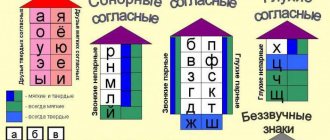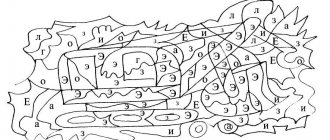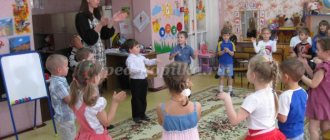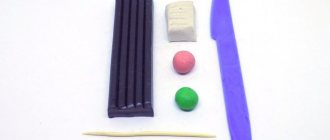Abstract “Sound analysis of words”
MADOU "DS No. 48" SEVERSK TOMSK REGION
SOUND-LETTER ANALYSIS OF WORDS
Educator: Ilyinskaya Diana Vitalievna
2015
Goals and objectives: development of sound-letter analysis and synthesis of words; learn to correlate sounds with letters and symbols.
Teaching children to read and write in kindergarten is carried out using the analytical-synthetic method. This means that children are introduced to the sounds of their native language first and then to the letters. A modern school, according to the Federal State Educational Standard, requires from children entering the first grade not so much any amount of knowledge and skills, but the ability to act in the mental plane, which is formed in the process of mastering a system of knowledge in a particular area of reality. Therefore, already at preschool age, it is necessary to help children master a certain system of knowledge, which will become the basis for future study of the subject. Sound analysis is the determination, firstly, of the order of sounds in a word, secondly, the selection of individual sounds, and thirdly, the distinction of sounds according to their qualitative characteristics. The Russian language is characterized by the opposition of vowels and consonants, hard and soft consonants. The ability to hear and isolate all sounds in order prevents skipping letters in the future when writing. After classes in the middle group, five-year-old children are prepared to master sound analysis: they can identify sounds intonationally and determine the first sound in words. But in order for a child to analyze a word, its sound composition must be materialized. The spoken word escapes, and it is very difficult for a child to identify certain parts or elements in it. It needs to be shown to preschoolers in terms of subject matter, presenting the sound structure in the form of a model. For this purpose, a picture-scheme of the sound composition of words is used. It depicts an object, the name of which the child parses and places a row of chips under the picture according to the number of sounds in the word. The drawing helps to always see the object whose name is being analyzed. The diagram makes it possible to determine the number of sounds in a word and check the correctness of its filling with chips.
The main type of exercise that develops students' phonetic abilities is phonetic analysis.
Familiarization with the curriculum shows that phonetic analysis means sound-letter analysis. However, the methodology distinguishes between actual phonetic (or sound, and phonetic-graphic (or sound-letter)) analysis. The purpose of the first is to characterize the sound structure of a word without resorting to letters, the second includes actual phonetic analysis only as its initial stage, since its main task is to clarify the relationship between the sound structure of a word and its letter designation.
Children actually perform sound analysis during the preparatory period of learning to read and write. With the transition to the study of letters, sound analysis is unfairly almost completely eliminated from use.
However, noting the importance of phonetic analysis itself, one cannot help but admit that it is natural that the main type of exercise from the moment children become familiar with letters is sound-letter analysis in its two varieties.
If we want to ensure that the child actually operates with sounds, that is, so that his phonetic hearing develops, it is advisable to conduct sound analysis in this sequence.
- Say and listen to the word
- Find the stressed syllable
- Say the word syllable by syllable
- Draw out (highlight with your voice) the first sound in a complete word, name it and describe it
- Indicate the selected sound with a symbol
- Do this until the end of the word
- Say all the named sounds in a row. Listen to whether the word came out.
Let's comment on each point of this plan.
- Say and listen to the word. This stage in working on a word is extremely important for the development of phonemic hearing of the child who is presented with the object of the upcoming analysis. The sounding word exists for an instant. Then he disappears. It is invisible, intangible. At the same time, it is necessary to ensure that students pronounce words in accordance with the norms of Russian literary pronunciation. Thus, the first stage of working with a word during sound analysis also becomes a means of developing a culture of oral speech in students.
- Find the stressed syllable. Before isolating individual sounds in a word, it is necessary to find a stressed syllable, since the lexical meaning of the word sometimes depends on this. For example: [zamo'k], [zamo'k]. At the same time, children should know that a stressed syllable is only in a complete word.
- Say the word syllable by syllable. The student must say the word twice. The first time he pronounces it entirely with a questioning or vocative intonation, which helps to easily find the stressed syllable. The second time the word is pronounced syllable by syllable.
- Draw out (highlight with your voice) the first sound in a complete word, name it and describe it. This is actually the beginning of the sound analysis of the word. Children need to be taught to stretch out the sound, artificially lengthen it, or designate it in some other way. For example, if the sound is plosive ([k], [d]…), it can be repeated [kkot] or pronounced with effort while exhaling. This will help you hear the sound better. By isolating a sound in a complete word, the child controls whether the word is distorted, since there is an inextricable connection between the lexical meaning and the sound of the word. Distortion of one of the elements of this integral connection destroys it.
- Indicate the selected sound with a symbol. At the stage of sound analysis of a word, its recording with conventional symbols of each sound should not be associated with letter symbols. Over time, children, led by the teacher, will correlate these conventional icons with transcription icons and write the word like this: [p'is'mo]. At first, words that do not have spellings are used for sound analysis.
Sound-letter analysis is one of the most important types of work, which contributes to the further formation of spelling vigilance and the development of phonemic hearing; developing the ability to isolate sounds in a word, correctly name and characterize them; the ability to correlate a word with its sound pattern and much more.
I carry out the work of sound-letter analysis of a word as follows:
I. I distribute cards:
- I find out:
1. What is shown in the picture?
2. Divide the word into syllables (draw a line with a colored pencil), put an emphasis (with a colored pencil).
3. Count the cells with letters?
4. Count the empty cells?
5. Which cells are there more (or less)?
6. Let's find out why there are more empty cells (fewer, the same)? The letter Yu gives two sounds [th] and [y], and in the word trees - ь - does not indicate the sound [], but the letter i - gives two sounds [th] and [a] rush - does not make a sound).
7. We pronounce the word, listen to ourselves: we find out that the letter Y makes two sounds.
8. Type sounds into empty cells.
9. We find out whether all sounds are pronounced in the same way as they are written (printed), that is, we check the spelling of the word with the sound scheme. (For example, in the word lion
- the letter
v
will give the sound [f];
in the word trees - b - does not indicate the sound [], but the letter i - gives two sounds [th] and [a], fruit - the letter d
- gives the sound [t]).
10. We give a description of sounds (vowel - stressed, unstressed, consonant - hard, soft, voiced, voiceless), coloring the squares with colored pencils (green, blue, red), or laying out colored squares (green, red, blue) in accordance with the characteristics sound.
In their work they relied on the research of: A. M. Borodich, G. S. Shvaiko, A. I. Maksakova, A. N. Gvozdeva, E. V. Kolesnikova, G. G. Golubeva, G. A. Tumakova, V. V. Gerbova, T. A. Tkachenko, A. K. Bondarenko, E. A Strebeleva, T. B. Filicheva, N. V. Novotortseva, etc., using the tables:
List of used literature.
1. Aleksandrova T.V. “Living sounds or phonetics for preschoolers” // “Child in kindergarten”. - 2005. - No. 5, 6, 7, 8.
2. Vasilyeva V.V. “Program for the education and training of children in kindergarten.” - M.: “Enlightenment”, 2008.
3. Gerbova V.V. “Development of speech of older preschoolers in kindergarten” - M.: “Prosvesh 2008.”
4. Ilkonin D. B. “How to teach children to read” - M. :1976
5. Kolesnikova E. V. Program for preparing preschool children for literacy training “From sound to word” (author’s program), ed. 2 – e. M.: Publishing house. "Iuventa", 2001 - With. 18 6.
Kolesnikova E. V. “Development of sound-letter analysis in children 5-6 years old.” M.: ed. "Iuventa", 2003
7. Kolesnikova E. V. “Development of phonemic hearing in preschool children.” M.: ed. "Juventa" 2005
8. Kulikovskaya T. A. “The best speech therapy games and exercises for speech development” LLC publishing house ASTREL M.: 2009.
9. Maksakova A. I. “Is your child speaking correctly” - M.: Mosaic - Synthesis, 2005
10. Maksakova A.I. “Development of correct speech of a child in the family” - M.: Mosaic - Synthesis, 2005.



